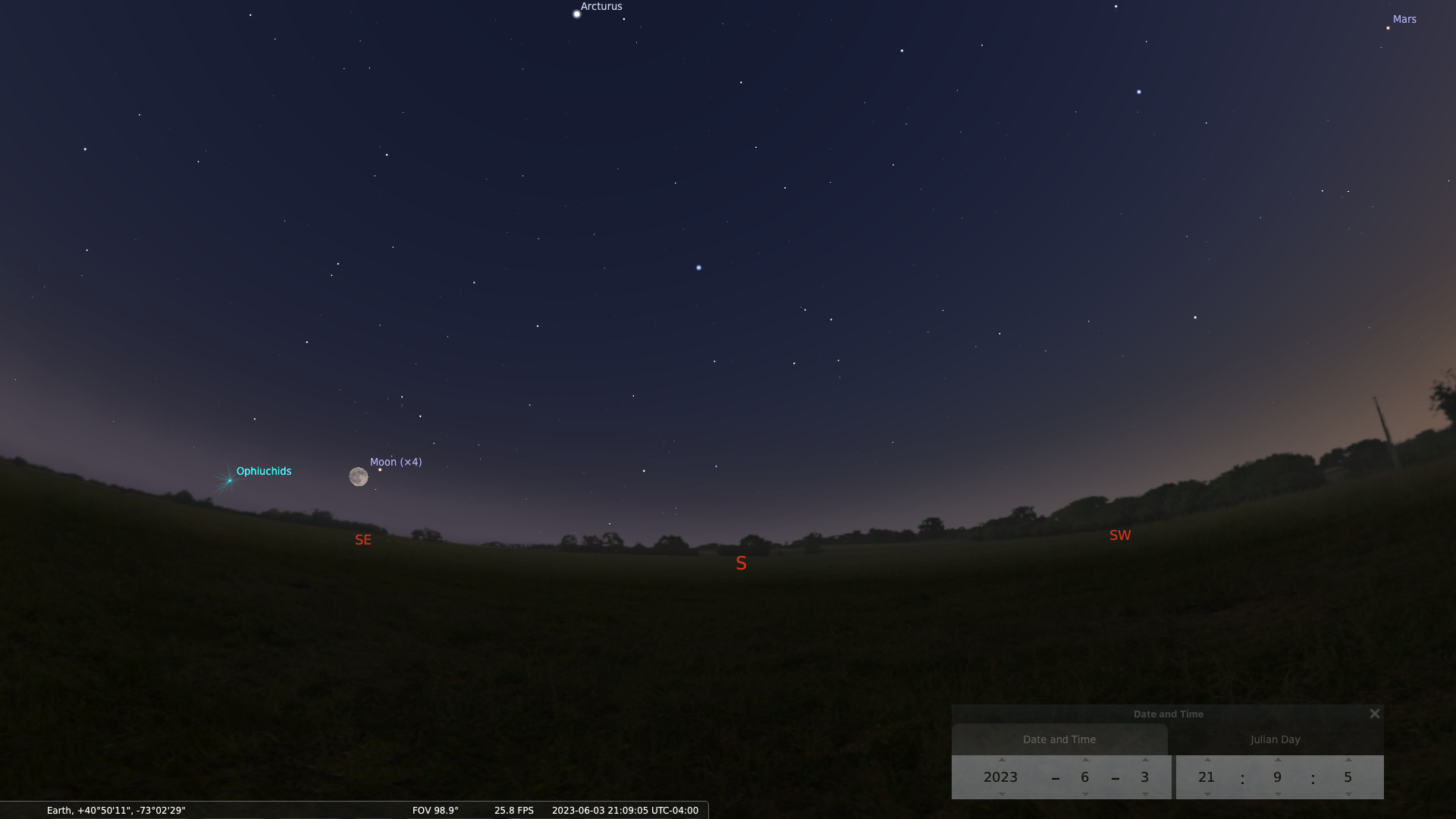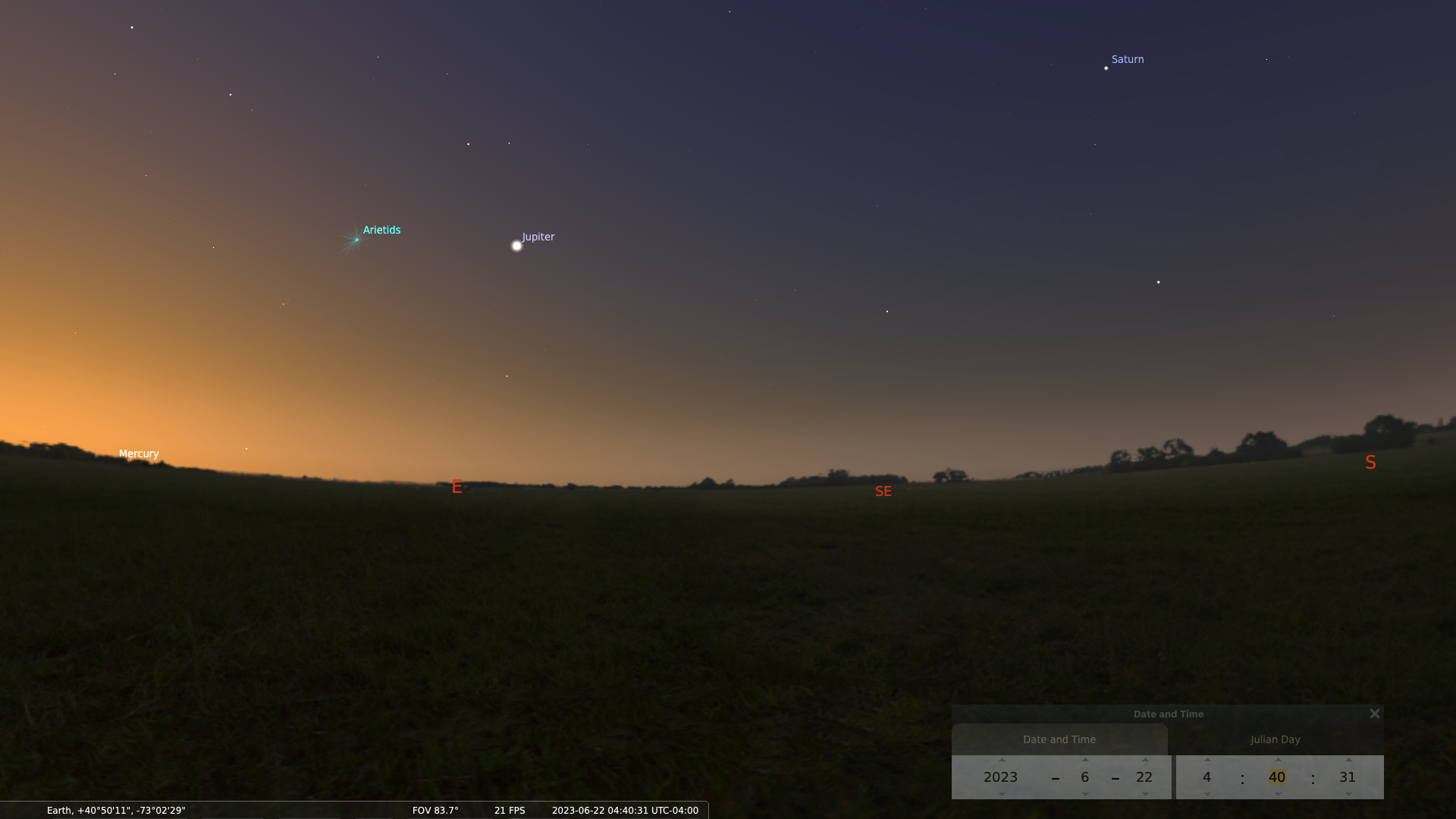The 2023 Summer Solstice, the Astronomical beginning of summer and the longest day of the year, occurs this year at 10:57AM, EDT on Wednesday, June 21st.
What is the Summer Solstice?

This year’s summer solstice illustrated with Stellarium shows the sun at the height of its travels above the southern horizon for 2023 on June 21st. Without the atmosphere, we would see the background stars and constellations of winter such as Orion, the hunter and Canis Major. Note the waxing crescent moon to the east, flanked by Venus and Mars just north of the ecliptic and south of the moon. These objects will be visible throughout Astronomical twilight and will follow the sun as it sets. The major planets to the west of the sun in this illustration, Mercury and Jupiter, will be early morning objects at dawn on June 22nd.
Often referred to as the ‘First Day of Summer‘, a subjective term, the Summer Solstice in the Northern Hemisphere is the day the sun is at its highest point above the southern horizon at midday. In practical terms, this is the moment during the year when Northern Hemisphere inhabitants receive the greatest amount of energy from the sun. This angle above the horizon, known as the ‘Angle of Insolation‘, determines how much energy is received [from the sun] at a given location.
Longest Day of the Year
The Summer Solstice marks the calendar as the longest day and, correspondingly, the shortest night in the Northern Hemisphere. Due to climactic factors and buffering by the earth’s atmosphere, we don’t feel the full effects of this maximum energy received for at least a month into July and August.
The seasons are reversed for our friends in the Southern Hemisphere. It is on this same day, they experience their Winter Solstice, or the point during the year when the sun is at its lowest point above the northern horizon.
This year’s summer solstice illustrated above with Stellarium shows the sun at the height of its travels above the southern horizon for 2022 on June 21st. Without the atmosphere, we would see the background stars and constellations of winter such as Orion, the hunter and Canis Major, the great dog. We also note the separation of the plane of the ecliptic (the plane of the solar system) and the Celestial Equator, the projection of the Earth’s equator onto the sky. This separation is exactly equal to the earth’s axial tilt of 23.5 degrees.
Seasonal Changes in Climate
The seasonal fluctuations in climate are not caused by a change in the earth-sun distance. All orbits are elliptical and, with earth’s orbital eccentricity of 0.0167, it’s nearly circular. All planets have a perihelion or closest point to the sun and an aphelion, furthest point. The earth’s perihelion occurs during January, the coldest month in the northern hemisphere and aphelion during July, the warmest month.
The earth’s axis remains tilted towards the same point on the sky in its orbit resulting in the sun’s changing elevation. This, in turn, causes the change in the Angle of Insolation and thus how much energy is received at the surface at a given location. The slight change in the earth-sun distance during the year has little or no effect on seasonal change in climate.
Seasonal Reflections
As the last vestiges of the winter sky are low in the west at twilight, we look forward to the late spring and early summer sky.
With Lyra, the celestial harp, ascending the northeastern sky towards midnight along with Cygnus and the rich summer Milky Way following close behind, we’re certain that warm summer months will soon follow. Many would consider this their favorite time of year, a time that hearkens back to younger days, to a time when you could see magnitude 5.5 stars (the faintest stars visible to the eye are magnitude 6) and a breathtaking view of the Milky Way from many suburbs. With the fresh spring air, the smell of Lilacs and Honey Suckle wafting about with the temperature and humidity still moderate, it’s truly a pleasure to be out under the stars.
June’s Full Moon

Paddleboarders below a rising Strawberry Moon at Barceloneta beach, Barcelona, Spain. DinoGeromella/iStockphoto.com
On June 3rd, 18 days before the Summer Solstice this year, the full moon for June, historically known as the Strawberry Moon, will occur at 11:41 PM, EDT. Each month’s full moon is identified with a natural occurrence or aspect of nature particular to that month.
June’s Full moon occurs during the time of year when wild strawberries start to ripen during early summer. The Strawberry moon is also known as the Rose Moon, Hot Moon, or the Mead Moon. Additional information on the lore of the moon and its names can be found here.
The Night Sky on the night of the Full Strawberry Moon
The Full Strawberry Moon for this year occurred on June 3rd, 2023. In this view to the southeast, we see the full strawberry moon, immediately to the south and east of Antares, the heart of Scorpio, the Scorpion. For an explanation of full moon names and the association with different times of the year, please see the previous paragraph.

In this view to the southeast on June 3rd, we see the full strawberry moon, immediately to the east of Antares, the heart of Scorpio, the Scorpion. For an explanation of full moon names and the association with different times of the year, please see the previous paragraph.
The Night Sky for June 21st, 2022, the day of the Summer Solstice
In the following view to the south approaching midnight is the brilliant galactic center with the “Tea Pot” of Sagittarius, Scorpio the scorpion and brilliant Antares, the heart of the scorpion, in the foreground, set against the backdrop of the galactic center 25,000 light years distant. These well-known hallmarks of the summer sky are almost at the meridian at 11:00 PM. It should be recalled when gazing south towards our galaxy’s center in this vista, the galactic center is over 25,000 light years distant and that all the bright stars (including Antares) are well in the foreground.

In this view to the south approaching midnight is the brilliant galactic center with Sagittarius, Scorpio and brilliant Antares, the heart of the scorpion, in the foreground. These well-known hallmarks of the summer sky are almost at the meridian at 11:00 PM.
The Pre-Dawn Hours of June 22nd
In the pre-dawn hours of June 22nd, early risers will be witness to a stunning sight to the east and south. At 3:00 AM, the waning crescent moon will be flanked by Mars immediately to the east and Jupiter to the west with Saturn further west along the ecliptic.

In this view to the east and south at 4:40 AM on June 22nd, are 3 of the major planets to the west of the rising sun, Mercury, Jupiter and Saturn with Mercury hugging the horizon at this time. This view is consistent with the view presented at the top of the page.
Astronomy For Change: https://astronomyforchange.org
Buy us a Coffee? https://www.buymeacoffee.com/astronomychange
Follow Us On Twitter: https://twitter.com/astronomychange
Why not support us on Patreon: https://www.patreon.com/astronomyforchange
Imagination is more important than knowledge
![]()
An index of all articles can be found here.
If you enjoyed this article, please consider supporting us with a modest donation
or through a subscription on our Patreon Page
Membership at Astronomy for Change is Free!



